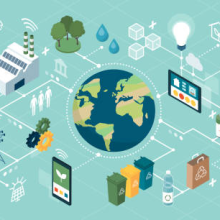The Truth About Green Living Costs: Debunking Myths and Sharing Tips
The concept of green living is becoming increasingly popular, but there are still many misconceptions about the costs associated with it.
Many people believe that green living, that is, living a more sustainable lifestyle is expensive and time-consuming, but this is simply not true.
Are you curious about green living but hesitant to adopt eco-friendly practices because of the cost?
But the truth is, green living can actually save you money in the long run while also benefiting the environment.
In this article, we’ll explore the truth about green living costs. Article on saving money and the planet – Green Living Made Easy can also provide valuable resource.
We also debunk some common myths, and share practical tips for adopting eco-friendlier habits without breaking the bank in this guide.

1: The Financial Benefits of Green Living
Contrary to popular belief, green living doesn’t have to be expensive. In fact, it can actually save you money in the long run.
Eco-friendly practices not only benefit the environment but also have financial benefits. Adopting these practices can help individuals save money in the long run.
Here are some of the financial benefits of eco-friendly practices:
- Lower energy bills: One of the most significant financial benefits of eco-friendly practices is lower energy bills. By reducing energy consumption, homeowners can save money on their monthly electricity bills. Simple actions like turning off lights when leaving a room, using energy-efficient appliances, and unplugging electronics when not in use can significantly reduce energy usage and save money.
- Reduced water bills: Conserving water by fixing leaky faucets, taking shorter showers, and installing low-flow toilets can lower your water bill. By using water-saving devices and being mindful of water usage, individuals can reduce their water consumption and save money on monthly bills.
- Savings on transportation: Eco-friendly practices can also save individuals money on transportation. Walking, biking, or taking public transportation instead of driving can save money on gas, car maintenance, and parking fees. Not only are these methods cheaper, but they are also better for the environment.
- Decreased healthcare costs: Adopting eco-friendly practices can also lead to decreased healthcare costs. For instance, eating a plant-based diet can improve health, reduce the risk of chronic diseases, and lower healthcare costs. Similarly, reducing exposure to harmful chemicals can also improve health and reduce healthcare costs in the long run.
- Reduced waste disposal costs: Eco-friendly practices can also reduce waste disposal costs. Recycling and composting reduce the amount of waste sent to landfills, which can lead to lower garbage collection fees.
Ultimately, eco-friendly practices offer a range of financial benefits in addition to their environmental benefits.
By reducing energy and water consumption, adopting sustainable transportation methods, improving health, and reducing waste, individuals can contribute towards achieving a more sustainable future for our planet.
2: Debunking Myths About Green Living Costs
Myth #1: Green products are more expensive than conventional products.
While some eco-friendly products may have a higher upfront cost, they often last longer and are more durable, saving you money in the long run. Additionally, many green products are now competitively priced with conventional products.
Myth #2: Only wealthy people can afford to go green.
Green living is not just for the wealthy. In fact, many sustainable practices are free or low-cost, such as reducing water and energy usage and choosing to walk or bike instead of driving.
There are also many affordable eco-friendly products available that can help you reduce waste and save money over time.
Myth #3: Green homes are more expensive to build and maintain.
While some green building practices may have a higher upfront cost, they often save money in the long run by reducing energy and water usage.
Additionally, there are many ways to make your home more sustainable that are low-cost or even free, such as sealing air leaks and insulating your home.
3: Tips for Adopting Eco-Friendly Habits on a Budget
Now that we’ve debunked some common myths about green living costs, here are some practical tips for adopting eco-friendly habits on a budget:
- Reduce energy consumption: Unplug electronic devices when not in use, switch to energy-efficient light bulbs, and use a programmable thermostat to save on heating and cooling costs.
- Conserve water: Fix leaks, take shorter showers, and install low-flow showerheads and faucets.
- Use sustainable transportation: Walk, bike, or use public transportation whenever possible. If you must use a car, carpool, or consider purchasing a fuel-efficient vehicle.
- Reduce waste: Buy products with minimal packaging, bring your own reusable bags and containers, compost food scraps, and recycle.
- Choose eco-friendly products: Look for products made from sustainable materials and with environmentally-friendly production methods. Consider buying second-hand items instead of new ones.
- Use natural cleaning products: Instead of harsh chemicals, use natural cleaning solutions like vinegar, baking soda, and lemon juice.
- Eat locally and seasonally: Support local farmers and reduce the carbon footprint of your food by buying produce that is in season and grown locally.
By implementing these eco-friendly habits, individuals can make a significant impact on the environment while still maintaining a budget.
Conclusion
Living sustainably doesn’t have to be expensive. In fact, adopting eco-friendly habits can actually save you money in the long run while also benefiting the environment. By following the tips and debunking the myths in this article, you can make small changes to your daily routine that will have a big impact on your wallet and the planet.
The following reputable websites should provide you with additional information and resources to further your understanding of green living and its financial benefits:
- The Environmental Protection Agency (EPA) provides information on eco-friendly practices, products, and policies: https://www.epa.gov/
- Energy Star offers energy-efficient product ratings and tips for reducing energy consumption: https://www.energystar.gov/
- The Natural Resources Defence Council (NRDC) is a non-profit environmental advocacy group that provides resources and tips for sustainable living: https://www.nrdc.org/
- The United States Department of Energy (DOE) offers energy-saving tips and resources for homeowners and renters: https://www.energy.gov/
- The World Wildlife Fund (WWF) provides information on conservation efforts and tips for sustainable living: https://www.worldwildlife.org/


